Gary Grant
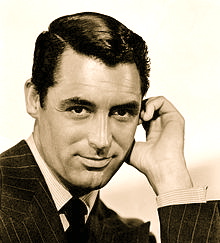
Tony Curtis on Cary Grant

Tony Curtis gives the profile of his idol, Cary Grant, for TCM.
photo of Gary Grant in 1941
Archibald Alexander Leach (18 January 1904 – 29 November 1986), better known by his stage name Cary Grant, was an English actor who later gained American citizenship. Known for his transatlantic accent, debonair demeanor and “dashing good looks”, Grant is considered one of classic Hollywood‘s definitive leading men.
Grant was named the second Greatest Male Star of All Time by the American Film Institute. Noted particularly for his work in comedy but also for drama, Grant’s best-known films include The Awful Truth (1937), Bringing Up Baby (1938), Gunga Din (1939), The Philadelphia Story (1940), His Girl Friday (1940), Arsenic and Old Lace (1944), Notorious (1946), To Catch A Thief (1955), An Affair to Remember (1957), North by Northwest (1959) and Charade (1963).
Nominated twice for the Academy Award for Best Actor, for Penny Serenade (1941) andNone But the Lonely Heart (1944), and five times for a Golden Globe Award for Best Actor, Grant was continually passed over, and in 1970 was given an Honorary Oscar at the 42nd Academy Awards. Frank Sinatra presented Grant with the award, “for his unique mastery of the art of screen acting with the respect and affection of his colleagues.”
Early life and career
Archibald Alexander Leach was born at 15 Hughenden Road, Horfield, Bristol,Gloucestershire, England, to Elsie Maria Kingdon (1877–1973) and Elias James Leach (1873–1935). An only child, Leach had an unhappy upbringing, attending Bishop Road Primary School. His mother had suffered from clinical depression since the death of a previous child. Her husband placed her in a mental institution, and told his nine-year-old son only that she had gone away on a “long holiday”. Believing she was dead, Grant did not learn otherwise until he was 31 and discovered her alive in a care facility. When Grant was 10, his father abandoned him after remarrying and having a baby with his new young wife.
Grant was expelled from the Fairfield Grammar School in Bristol in 1918. After joining the “Bob Pender Stage Troupe”, Leach performed as a stilt walker and travelled with the group to the United States in 1920 at the age of 16, on a two-year tour of the country. He was processed at Ellis Island on 28 July 1920.
When the troupe returned to the UK, he decided to stay in the U.S. and continue his stage career. During this time, he became a part of the vaudeville world and toured with Parker, Rand and Leach. Still using his birth name, he performed on the stage at The Muny in St. Louis, Missouri in such shows as Irene (1931); Music in May (1931); Nina Rosa (1931); Rio Rita (1931); Street Singer (1931); The Three Musketeers (1931); and Wonderful Night (1931). Leach’s experience on stage as a stilt walker, acrobat, juggler, and mime taught him “phenomenal physical grace and exquisite comic timing” and the value of teamwork, skills which would benefit him in Hollywood.
Hollywood stardom
After appearing in several musicals on Broadway under the name “Archie Leach,” Grant went to Hollywood in 1931. When told to change his name, he proposed “Cary Lockwood,” the name of the character he had played in the Broadway show Nikki, based upon the recent film The Last Flight. He signed with Paramount Pictures, where studio bosses decided that the name “Cary” was acceptable, but that “Lockwood” was too similar to another actor’s surname. Paramount gave their new actor a list of surnames to choose from, and he selected “Grant” because the initials C and G had already proved lucky for Clark Gable and Gary Cooper, two of Hollywood’s biggest film stars.
Grant appeared as a leading man opposite Marlene Dietrich in Blonde Venus (1932), and his stardom was given a further boost byMae West when she chose him for her leading man in two of her most successful films, She Done Him Wrong and I’m No Angel (both 1933). I’m No Angel was a tremendous financial success and, along with She Done Him Wrong, which was nominated for an Academy Award for Best Picture, saved Paramount from bankruptcy. Paramount put Grant in a series of unsuccessful films until 1936, when he signed with Columbia Pictures. His first major comedy hit was when he was loaned to Hal Roach‘s studio for the 1937 Topper (which was distributed by MGM).
in The Philadelphia Story (1940)
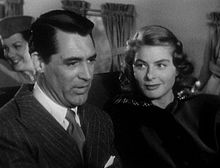 With Ingrid Bergman in Notorious (1946)
With Ingrid Bergman in Notorious (1946)
The Awful Truth (1937) was a pivotal film in Grant’s career, establishing for him a screen persona as a sophisticated light comedy leading man. As Grant later wrote, “I pretended to be somebody I wanted to be and I finally became that person. Or he became me. Or we met at some point.” Grant is said to have based his characterisation in The Awful Truth on the mannerisms and intonations of the film’s director, Leo McCarey, whom he resembled physically. As writer/director Peter Bogdanovich notes, “After The Awful Truth, when it came to light comedy, there was Cary Grant and then everyone else was an also-ran.”
The Awful Truth began “what would be the most spectacular run ever for an actor in American pictures.” During the next four years, Grant appeared in several classic romantic comedies and screwball comedies, including Holiday (1938), Bringing Up Baby (1938) and The Philadelphia Story (1940) (all three films opposite Katharine Hepburn) His Girl Friday (1940) with Rosalind Russell; and My Favorite Wife (1940), which reunited him with Irene Dunne, his co-star in The Awful Truth. During this time he also made the adventure films Gunga Din and Only Angels Have Wings (both 1939) and dramas Penny Serenade (1941, also with Dunne) and Suspicion (1941, the first of Grant’s four collaborations with Alfred Hitchcock).
Grant remained one of Hollywood’s top box-office attractions for almost 30 years.[7] Howard Hawks said that Grant was “so far the best that there isn’t anybody to be compared to him.” David Thomson called him “the best and most important actor in the history of the cinema.”
Grant was a favourite of Hitchcock, who called him “the only actor I ever loved in my whole life.” Besides Suspicion, Grant appeared in the Hitchcock classics Notorious (1946), To Catch a Thief (1955) and North by Northwest (1959). Biographer Patrick McGilligan wrote that, in 1965, Hitchcock asked Grant to star in Torn Curtain (1966), only to learn that Grant had decided to retire after making one more film, Walk, Don’t Run (1966); Paul Newman was cast instead, opposite Julie Andrews. Producers Broccoli and Saltzman originally sought Cary Grant for the role of James Bond in Dr. No, but discarded the idea as Grant would be committed to only one feature film, and the producers decided to go after someone who could be part of a franchise.
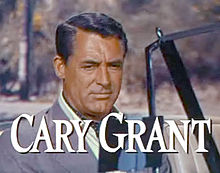 as John Robie in Alfred Hitchcock To Catch a Thief (1955)
as John Robie in Alfred Hitchcock To Catch a Thief (1955)
In the mid-1950s, Grant formed his own production company, Granart Productions, and produced a number of films distributed by Universal, such as Operation Petticoat (1959), Indiscreet (1958), That Touch of Mink (co-starring with Doris Day, 1962), and Father Goose (1964). In 1963, he appeared opposite Audrey Hepburn in Charade. His last feature film was Walk, Don’t Run three years later, with Samantha Eggar and Jim Hutton.
In Hitchcock’s North by Northwest(1959)
Grant was the first actor to “go independent” by not renewing his studio contract, effectively leaving the studio system, which almost completely controlled what an actor could or could not do. In this way, Grant was able to control every aspect of his career, at the risk of not working because no particular studio had an interest in his career long term. He decided which films he was going to appear in, he often had personal choice of the directors and his co-stars and at times even negotiated a share of the gross revenue, something uncommon at the time. Grant received more than $700,000 for his 10% of the gross for To Catch a Thief, while Hitchcock received less than $50,000 for directing and producing it.
Grant was nominated for two Academy Awards, for Penny Serenade (1941) and None But the Lonely Heart (1944), but never won a competitive Oscar; he received a special Academy Award for Lifetime Achievement in 1970. Accepting the Best Original ScreenplayOscar in 1965, Father Goose co-writer Peter Stone had quipped, “My thanks to Cary Grant, who keeps winning these things for other people.” In 1981, Grant was accorded the Kennedy Center Honors.
Never self-absorbed, Grant poked fun at himself with statements such as, “Everyone wants to be Cary Grant—even I want to be Cary Grant,” sometimes elaborating, “I pretended to be somebody I wanted to be and I finally became that person. Or he became me. Or we met at some point.” He poked fun at himself in ad-lib lines – such as in the film His Girl Friday, saying, “I never had so much fun since Archie Leach died”, and in Arsenic and Old Lace a gravestone is seen bearing the name Archie Leach. According to an extremely famous story now believed to be apocryphal, after seeing a telegram from a magazine editor to his agent asking “How old Cary Grant?” Grant reportedly responded with “Old Cary Grant fine. How you?”
Retirement and death
Cary Grant retired from the screen at 62 when his daughter Jennifer was born, in order to focus on bringing her up and to provide a sense of permanency and stability in her life. While bringing up his daughter, he archived artifacts of her childhood and adolescence in a (bank quality) room sized vault he had installed in the house. His daughter attributed this meticulous collection to the fact that artifacts of his own childhood had been destroyed during the Luftwaffe’s bombing of Bristol in the Second World War (an event that also claimed the lives of his uncle, aunt and cousin as well as the cousin’s husband and grandson) and he may have wanted to prevent her from experiencing a similar loss.
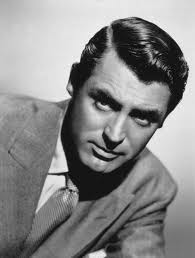 Cary Grant in 1949; he had the mole on his cheek removed the following year.
Cary Grant in 1949; he had the mole on his cheek removed the following year.
Although Grant had retired from the screen, he remained active in other areas. In the late 1960s, he accepted a position on the board of directors at Fabergé. By all accounts this position was not honorary, as some had assumed; Grant regularly attended meetings and his mere appearance at a product launch would almost certainly guarantee its success. The position also permitted use of a private plane, which Grant could use to fly to see his daughter wherever her mother, Dyan Cannon, was working. He later joined the boards of Hollywood Park, the Academy of Magical Arts (The Magic Castle, Hollywood, California), Western Airlines (now Delta Air Lines) and MGM.
In the last few years of his life, Grant undertook tours of the United States in a one-man show, A Conversation with Cary Grant, in which he would show clips from his films and answer audience questions. Grant was preparing for a performance at the Adler Theatre in Davenport, Iowa on the afternoon of 29 November 1986 when he sustained a cerebral haemorrhage (he had previously suffered a stroke in October 1984). He died at 11:22 pm in St. Luke’s Hospital at the age of 82. The bulk of his estate, worth millions of dollars, went to his fifth wife, Barbara Harris, and his daughter, Jennifer Grant.
In 2001, a statue of Grant was erected in Millennium Square, a regenerated area next to the harbour in his city of birth, Bristol.
In November 2005, Grant came in first in the “The 50 Greatest Movie Stars of All Time” list by Premiere Magazine. Richard Schickel, the film critic, said about Grant: “He’s the best star actor there ever was in the movies.”
Personal life
Second wife Barbara Hutton
Marriages and significant romantic relationships
Grant was married five times. He wed Virginia Cherrill on 10 February 1934. She divorced him on 26 March 1935, following charges that Grant had hit her. In 1942, he married Barbara Hutton, one of the wealthiest women in the world, and became a father figure to her son, Lance Reventlow. The couple was derisively nicknamed “Cash and Cary”, although in an extensive prenuptial agreementGrant refused any financial settlement in the event of a divorce. After divorcing in 1945, they remained lifelong friends. Grant always bristled at the accusation that he married for money: “I may not have married for very sound reasons, but money was never one of them.”
Wife Betsy Drake in trailer of her film with Grant, Every Girl Should Be Married (1948)
On 25 December 1949, Grant married Betsy Drake. He appeared with her in two films. This would prove to be his longest marriage, ending on 14 August 1962. Drake introduced Grant to LSD, and in the early 1960s he related how treatment with the hallucinogenic drug — legal at the time — at a prestigious California clinic had finally brought him inner peace after yoga, hypnotism and mysticism had proved ineffective. Grant and Drake divorced in 1962.
He eloped with Dyan Cannon on 22 July 1965, in Las Vegas. Their daughter, Jennifer Grant, was born prematurely on 26 February 1966. He frequently called her his “best production” and regretted that he had not had children sooner. The marriage was troubled from the beginning, and Cannon left him in December 1966, claiming that Grant flew into frequent rages and spanked her when she “disobeyed” him. The divorce, finalised in 1968, was bitter and public, and custody fights over their daughter went on for nearly ten years.
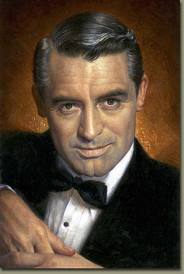 On 11 April 1981, Grant married long-time companion Barbara Harris, a British hotel public relations agent, who was 47 years his junior. They renewed their vows on their fifth wedding anniversary. (Fifteen years after Grant’s death, Harris married former Kansas Jayhawks All-American quarterback David Jaynes in 2001.)
On 11 April 1981, Grant married long-time companion Barbara Harris, a British hotel public relations agent, who was 47 years his junior. They renewed their vows on their fifth wedding anniversary. (Fifteen years after Grant’s death, Harris married former Kansas Jayhawks All-American quarterback David Jaynes in 2001.)
Some, including Hedda Hopper and screenwriter Arthur Laurents, have said that Grant was bisexual, the latter writing that Grant “told me he threw pebbles at my window one night but was luckless.” Grant allegedly was involved with costume designer Orry-Kelly when he first moved to Manhattan, and lived with actor Randolph Scott off and on for 12 years. Publicity photographs of Grant and Scott taken in 1933 at their home and at the beach, especially the one where Scott is lighting Grant’s cigarette, fanned the rumours. Richard Blackwell wrote that Grant and Scott were “deeply, madly in love,” and alleged eyewitness accounts of their physical affection have been published. Alexander D’Arcy, who appeared with Grant in The Awful Truth, said he knew that Grant and Scott “lived together as a gay couple”, adding: “I think Cary knew that people were saying things about him. I don’t think he tried to hide it.” The two men frequently accompanied each other to parties and premieres and were unconcerned when photographs of them cozily preparing dinner together at home were published in fan magazines. Scotty Bowers alleged in his memoir Full Service, published in 2012, that he was a lover of both Grant and Scott.
Barbara, Grant’s widow, has disputed that there was a relationship with Scott. When Chevy Chase joked about Grant’s being gay in a television interview, Grant sued him for slander; they settled out of court. However, Grant’s one-time girlfriend Maureen Donaldson wrote in her 1989 memoir, An Affair to Remember: My life with Cary Grant, that Grant told her that his first two wives had accused him of being homosexual. In Chaplin’s Girl, a biography of Virginia Cherrill (Grant’s first wife), the writer Miranda Seymour acknowledged that Grant and Scott were only platonic friends.
Former showgirl Lisa Medford claimed that Cary Grant wanted her to have his child, but she didn’t want kids, and “he was basically gay, and I wasn’t in love with him.” Grant’s daughter Jennifer Grant denied that her father was gay in her 2011 memoir but added that her “dad somewhat enjoyed being called gay. He said it made women want to prove the assertion wrong.” Jennifer’s mother, Dyan Cannon, Grant’s fourth wife, also denied that Grant was gay when she was promoting her memoir of Grant in 2012. Grant’s third wife Betsy Drake commented: “Why would I believe that Cary was homosexual when we were busy fucking?”






